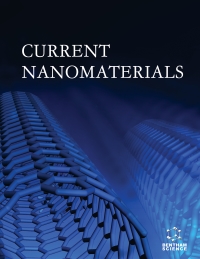- Home
- A-Z Publications
- Current Nanomaterials
- Previous Issues
- Volume 10, Issue 1, 2025
Current Nanomaterials - Volume 10, Issue 1, 2025
Volume 10, Issue 1, 2025
-
-
Potential and Harmful Effects of Titanium Dioxide Nanoparticle on Health: A Brief Note
More LessTitanium dioxide nanoparticles (TiO2 NPs) are formed in vast amounts worldwide for usage in several applications. They possess excellent photocatalytic properties, high chemical stability, and a wide bandgap, making them highly effective in environmental remediation and solar energy conversion. TiO2 nanoparticles exhibit biocompatibility, allowing their utilization in biomedical uses, such as molecular imaging, drug deli Read More
-
-
-
A Review on Carbon Nanotubes and its Biomedical Applications
More LessAuthors: Sonia Singh, Vandana Chauhan and Piyali BarikCarbon nanotubes, as their name implies, are nanotubes made of carbon. Carbon nanotubes, liposomes, dendrimers, quantum dots, nanogels, and others are carbon nanoparticles. CNTs are synthesized using a variety of processes, including laser ablation, chemical vapor deposition, and arc discharge. Each method affects the nanotubes' final structure, diameter, and chirality, which affects their qualities and future applicatio Read More
-
-
-
Revolutionizing Medicine: The Promise of Camouflage Nanoparticles - A Review
More LessAuthors: Vajagathali Mohammed and Nikitha Shalom RichardCamouflage nanoparticles (CNPs) have emerged as a promising paradigm in the realm of disease therapy, offering a distinctive set of properties and versatile applications. These nanoparticles, characterized by their size, typically falling within the range of 1 to 100 nm, hold significant promise for the realms of targeted drug delivery, diagnostics, and imaging. Diverse categories of camouflage nanoparticles, encompassing lipos Read More
-
-
-
Overcoming the Therapeutic Limitation of Ocular Drug Delivery with the Help of Novel Drug Carriers
More LessAuthors: Sumbul Shadab, Md. Aftab Alam, Pramod Kumar Sharma and Deepika PaliwalOne of the difficult areas of pharmaceutical research is the controlled delivery of drugs to the eye. The drainage of the solution, the quick turnover of the tears, and the diluting effects of lacrimation all contribute to a short drug contact time and poor ocular bioavailability with conventional systems. Drug delivery system design is also governed by the eye's anatomical barriers and its physiological conditions. To prevent retin Read More
-
-
-
Implementation of Nanocarriers for Brain-Specific Drug Delivery System
More LessAuthors: Aditya Sharma, Md. Aftab Alam and Awaneet KaurThere are several safeguards in place to protect the brain from injury because of its vulnerability. Two major barriers prevent harmful substances from entering the brain: the blood-brain barrier (BBB) and the blood-cerebrospinal fluid barrier (BCSFB). Although there has been some success in devising ways for transporting medicines to the brain, the great majority of the nanoparticles (NPs) used in these procedures are destro Read More
-
-
-
Synthesis of Cu-doped ZnO Nanoparticles Using Aloe vera Leaf Extract for Antibacterial and Photocatalytic Activities Evaluation
More LessAuthors: Mulatu Degefa, Guta Muleta and Kirubel TeshomeBackgroundFabrication of nanoparticles (NPs) by the biological approach has gained extensive attention recently due to its low cost, simplicity, non-toxic and environmentally-friendly nature, as compared to the toxic as well as expensive chemical and physical methods. This study aimed to synthesize ZnO and Cu-doped ZnO NPs using Aloe vera leaf extract for their photocatalytic and antibacterial activities evaluation.Metho Read More
-
-
-
Study of Structural and Optical Properties of Copper, Manganese, and Mixed Metal (Cu And Mn) Oxide Nanoparticles
More LessAuthors: Vaishali Yadav, Rimpy Shukla, Krishna Swaroop Sharma and Sunil OhjhaBackgroundUnique optical and electronic properties are exhibited by semiconductors in nanoparticle state as compared to their bulk form. Copper and manganese are transition metals which show various oxidation states and all the oxides have different characteristics as nanomaterials. These metal oxides have various applications in biosensing, photocatalysis, etc.MethodsFor this work, pure copper and manganese oxide nano Read More
-
-
-
Fabrication and Physiochemical Characterization of Zinc Oxide Nanoparticles via Citric Assisted Auto Combustion Synthesis
More LessAuthors: Anuj Kumar Gond, Atendra Kumar, Himanshu Shekher, Anees A. Ansari, K.D. Mandal, Youngil Lee and Laxman SinghBackgroundThere are various synthetic routes to synthesize the ZnO particle. However, none of the routes is best suited for the synthesis of ZnO nanoparticles. Moreover, ZnO nanoparticles have potential industrial applications.AimsIn this research article, ZnO nanoparticles were synthesized by auto combustion route using the low-cost reagents zinc nitrate hexahydrate and citric acid as a precursor at 90-120°C.ObjectiveHerei Read More
-
Most Read This Month
Article
content/journals/cnm
Journal
10
5
false
en


